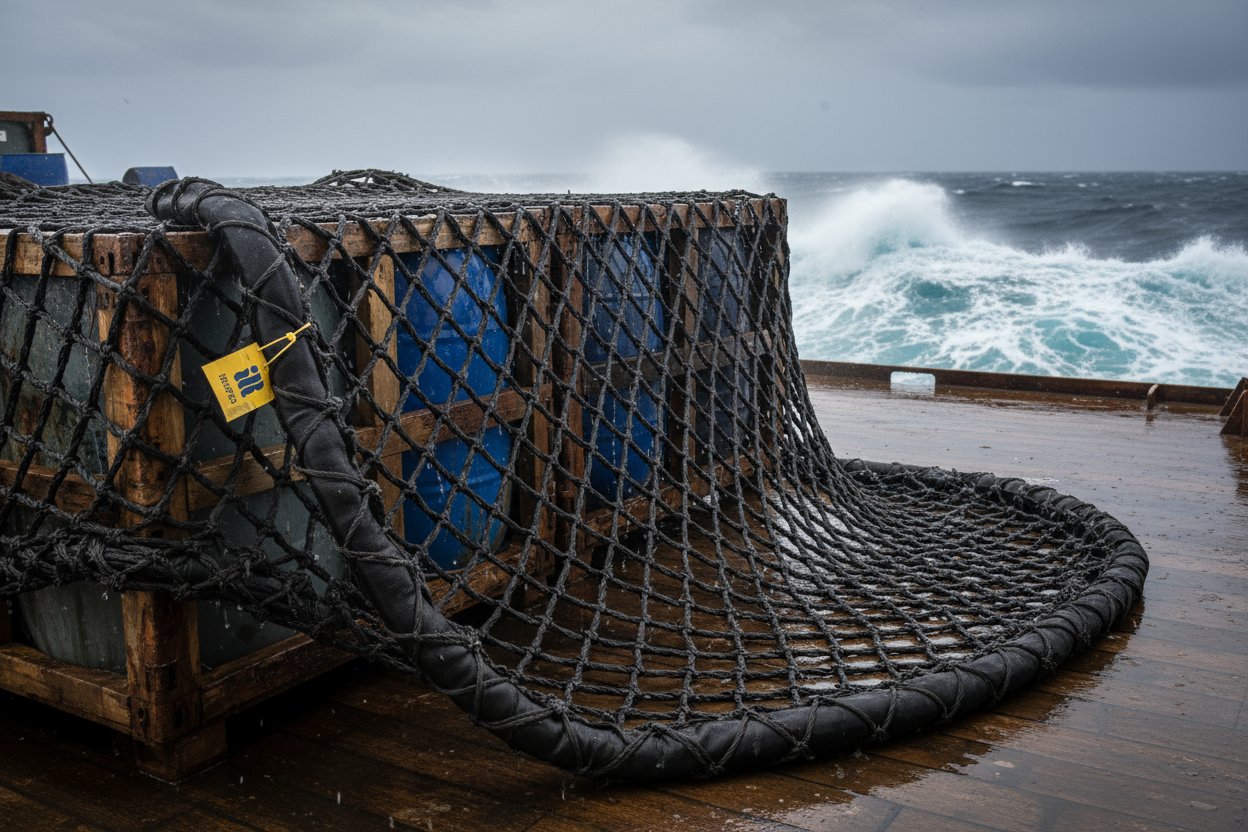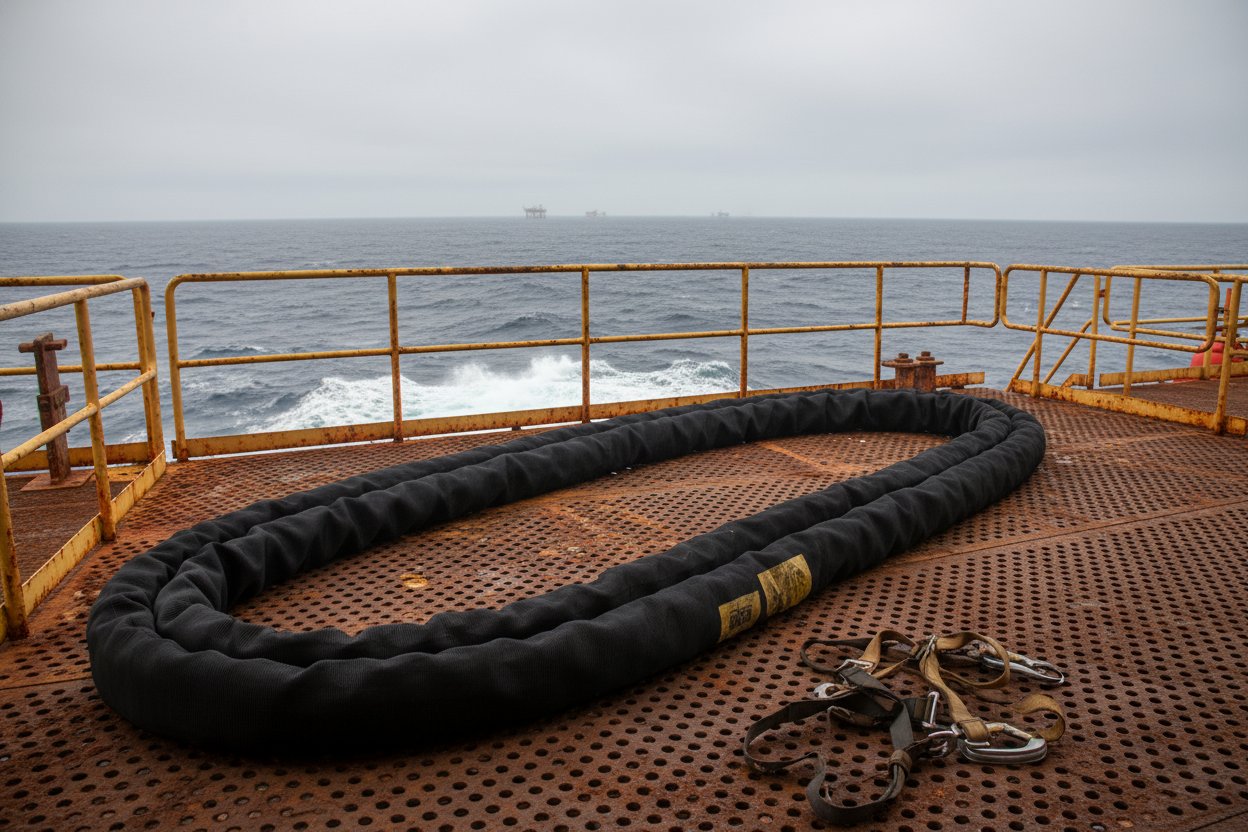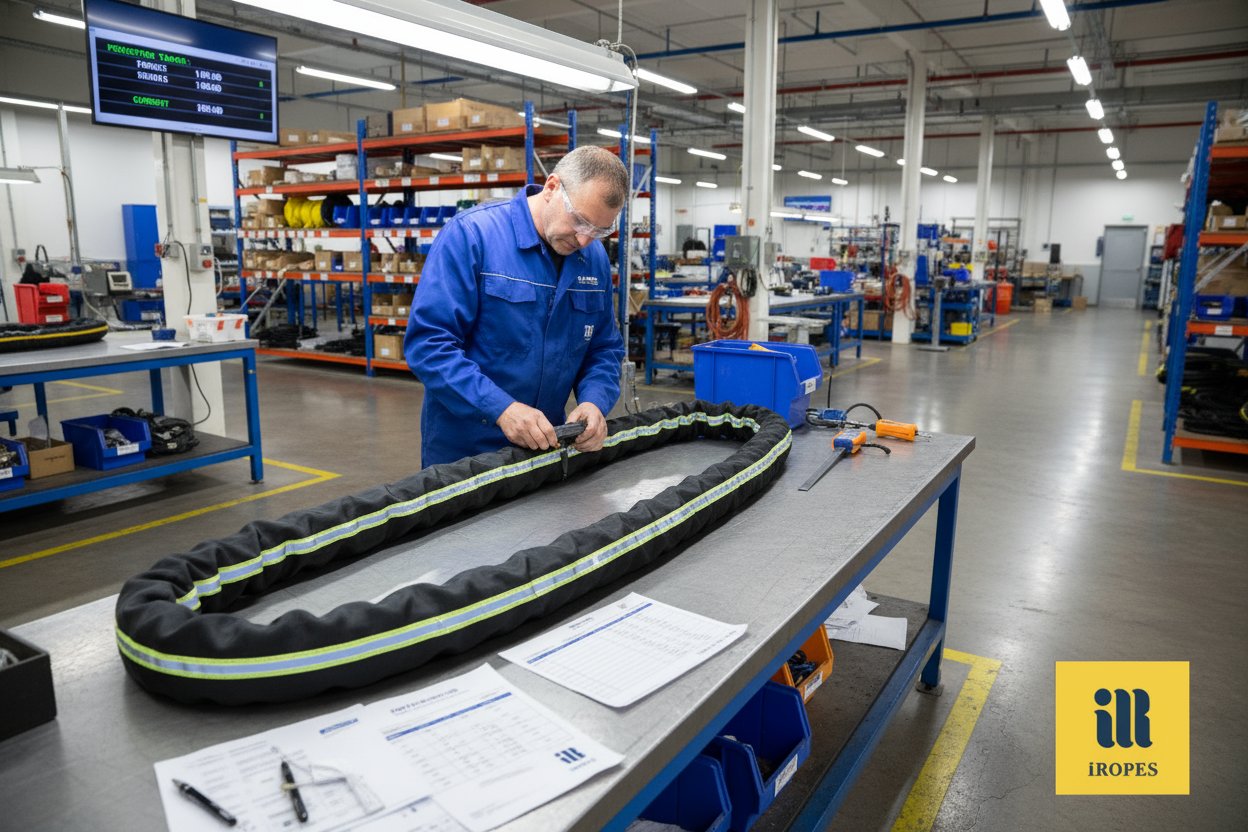Offshore incidents have seen a significant drop with the adoption of custom-engineered industrial slings, reliably handling 20-ton lifts in challenging saltwater environments. iRopes delivers ISO-certified solutions that enhance safety and operational efficiency in demanding marine operations.
Unlock Offshore Safety in 12 Minutes →
- ✓ Master sling types, including UHMWPE web designs, known for enhancing stability and control during precise marine lifts.
- ✓ Decipher material specifications—Nylon's shock absorption properties significantly reduce component stress in dynamic towing scenarios.
- ✓ Implement accurate WLL calculations and ISO inspection routines, ensuring comprehensive compliance for your marine assets.
- ✓ Learn from case studies demonstrating how industrial cargo nets have safeguarded high-value operations during adverse weather conditions.
Many believe offshore survival relies on chance amid unpredictable waves and corrosive salt. However, iRopes' tailored industrial slings, nets, and ropes are reshaping this perception, transforming potential hazards into successful outcomes. Have you considered how a customised Dyneema line—significantly lighter than steel yet exceptionally robust—could shield your crew from the impact of a rogue wave? This article explores how these innovations enhance marine safety, with practical applications demonstrating reliable, incident-free lifting and securing operations.
Industrial Slings: Revolutionising Safety in Offshore Lifting
In the demanding world of offshore operations, where every lift is critical, **industrial slings** are indispensable. They play a pivotal role in ensuring smooth progress and preventing potential incidents. This section explores how robust lifting gear is enhancing safety standards at sea, detailing how it keeps massive platforms and equipment stable amidst challenging marine conditions.
Types of Industrial Slings for Heavy-Duty Marine Work
Selecting the optimal industrial sling requires understanding the different types available. Each is designed to meet specific operational requirements. **Web slings**, constructed from flat polyester or nylon webbing, offer flexibility and are ideal for sensitive loads, conforming without damaging surfaces. **Round slings**, featuring an endless loop of synthetic fibres, provide even pressure distribution, making them suitable for awkwardly shaped items in confined spaces. Meanwhile, **rope slings**, crafted from braided or twisted cords, excel in high-tension applications where secure gripping and firm holding are paramount.
- Web Slings: Ideal for general lifting in marine environments, available in configurations such as eye-and-eye or endless loops for straightforward rigging.
- Round Slings: Designed for heavy offshore loads, often handling several tonnes due to their exceptional strength-to-weight ratio.
- Rope Slings: Highly adjustable and versatile for towing or securing tasks in dynamic environments, frequently used in emergency rescue operations.
Each type is engineered to address the specific challenges of salt water environments, ensuring reliable performance when it matters most.

Material Choices Engineered for Harsh Saltwater Conditions
Offshore operations demand materials that can endure constant exposure to salt, UV radiation, and abrasion. **Polyester** offers low stretch and chemical resistance, maintaining load stability even in turbulent seas. **Nylon**, though it absorbs some moisture, demonstrates superior impact recovery, making it suitable for dynamic lifting tasks. For peak performance, **UHMWPE** (such as Dyneema) provides remarkable strength with minimal weight, resisting corrosion effectively and outperforming conventional options in severe marine conditions.
Consider the benefits: if your sling is consistently exposed to saltwater spray, opting for materials that resist degradation over time translates into significant savings. These materials guarantee longevity, reducing replacement costs and minimising operational downtime.
Core Benefits
Why These Materials Matter
Corrosion Resistance
Polyester and UHMWPE effectively repel saltwater, preventing rust and material degradation over extended periods of use.
High Durability
Nylon effectively absorbs shocks from environmental forces, maintaining structural integrity during dynamic movements.
Lightweight Strength
UHMWPE delivers strength comparable to steel but with significantly less weight, simplifying offshore handling.
Practical Applications
For Everyday Offshore Tasks
Enhanced Safety
Low-stretch properties minimise load sway, reducing accident risks in challenging weather conditions.
Extended Lifespan
Excellent UV and abrasion resistance means less frequent inspections and replacements during projects.
Simplified Maintenance
These materials are easy to clean and maintain, unlike metal alternatives prone to rapid corrosion.
Staying Compliant: Certifications and Regular Checks
Safety in offshore environments extends beyond choosing the right equipment; it fundamentally relies on adherence to stringent standards. Industrial slings for offshore use must comply with **ISO 9001 certification** for quality manufacturing, ensuring consistent and reliable performance. **Working Load Limit (WLL) calculations** are crucial, taking into account the sling's material, angle of pull, and environmental stresses to establish safe usage parameters. These calculations define the maximum weight that can be safely lifted without risking failure. Regular inspections, both visual and through load tests performed every six months or after significant use, are essential. They help detect wear such as frays or UV damage early, safeguarding operations. Adhering to these protocols not only meets regulatory requirements but also protects personnel and assets from the unpredictable marine environment.
A Real-World Win: Lifting Platforms Safely
Consider a major offshore wind farm construction project off Australia's coast. The team faced the formidable task of lifting 20-ton platforms amidst persistent swells. Traditional lifting gear frequently failed due to corrosion, causing considerable delays. By switching to customised web slings from iRopes, made with UHMWPE for superior strength and durability, the operation was transformed. These slings performed flawlessly in the harsh saltwater conditions, reducing lift times by 30% and eliminating downtime caused by equipment replacements. This resulted in zero incidents and significantly smoother operations, giving the crew confidence in their equipment's resilience.
As lifting operations become more secure with such innovations, the next critical step involves ensuring broader load containment, particularly when sea conditions become unpredictable.
Industrial Cargo Net: Enhancing Load Security and Survival in Marine Operations
While robust industrial slings ensure precise lifts, managing larger loads amidst the ocean’s dynamic motion presents its own set of challenges. This is where **industrial cargo nets** become indispensable. They offer a reliable method for containing and protecting goods during turbulent voyages. These nets are more than mere barriers; they are crucial for preventing cargo spills that could endanger crew members or damage valuable equipment in offshore environments.
Design and Features That Endure the Sea
Fundamentally, industrial cargo nets are constructed in two primary forms: **knotted rope versions**, which utilise durable cords woven into flexible diamond patterns, and **webbing styles**, made from flat straps for a smoother, more uniform hold. Both types typically incorporate reinforced borders—featuring thicker ropes or webbing edges—to provide enhanced strength at points of maximum tension. Secure loops facilitate easy attachment to vessels or rigs. This design ensures effective containment for irregularly shaped items while offering fall protection, preventing objects from going overboard. Mesh sizes range from tight 50mm openings for small components to larger 300mm gaps for bulkier cargo, balancing optimal visibility with robust security.
Reinforced Borders
Extra-thick edges are designed to prevent tears under wave impact, ensuring the industrial cargo net maintains structural integrity even during sudden vessel movements.
Custom Mesh Options
Tailored mesh openings ensure cargo visibility while maintaining containment, adaptable for securing diverse items from tools to heavy machinery.
Fall Protection
These nets function as essential safety barriers on decks, significantly reducing injury risks from shifting loads in wet, slippery conditions.
Compact Storage
Designed to fold neatly when not in use, optimising space on often-cramped offshore platforms and vessels.
Selecting the Ideal Industrial Cargo Net for Your Needs
Choosing the correct industrial cargo net begins with a thorough assessment of your load's weight and dimensions. You must calculate the **Working Load Limit (WLL)**, which denotes the maximum safe capacity, typically ranging from 1,000 to 10,000 pounds, varying by net size and material. Next, consider the appropriate mesh size: smaller openings are ideal for containing fine items, while larger ones facilitate airflow around bulkier goods. Environmental factors also play a role; select UV-resistant materials like polypropylene for prolonged sun exposure or nylon for superior flexibility in colder waters. Finally, conduct a mock setup to ensure the net effectively covers your cargo without excessive sag. This systematic approach guarantees a net that precisely meets the demands of offshore operations.
- Evaluate load weight and required WLL.
- Determine mesh size based on item dimensions.
- Choose material for optimal weather resistance.
- Confirm dimensions and test assembly for fit.

Deploying Cargo Nets in Demanding Marine Scenarios
In practical offshore applications, these nets prove invaluable during towing operations, where they securely encase dragged equipment, preventing snags or uncontrolled drifting. For transport on heaving decks, they are essential for lashing down pallets of supplies, ensuring stability against significant wave heights. Furthermore, operators involved in oil rig transfers consistently rely on them to bundle pipes and tools, facilitating safe handoffs between platforms and thereby preventing any losses.
A Success Story from Rough Waters
Consider a recent towing operation in the North Sea: a supply vessel, heavily laden with drilling components, encountered gale-force winds. Standard, off-the-shelf nets proved inadequate, quickly fraying and risking costly equipment loss. iRopes provided custom rope **industrial cargo nets** with a 100mm mesh and polypropylene construction for superior water resistance, rated at 5,000 pounds WLL. Deployed across the deck, these nets effectively secured all cargo for 48 hours of tumultuous conditions, preventing any losses and enabling the operation to conclude two days ahead of schedule. The crew reported a noticeable reduction in safety incidents, attributing the smoother, safer journey to the reliable grip of the customised nets.
Such effective containment solutions are built upon robust foundations, epitomised by the high-performance **industrial ropes** that integrate these systems for ultimate resilience.
Industrial Rope: Building Resilience for Offshore Survival Challenges
The high-performance ropes previously mentioned are not merely supportive elements for cargo nets; they form the very backbone of comprehensive offshore safety systems. These ropes demonstrate remarkable toughness, adapting effectively to the rigorous demands of the sea. In critical situations, such as unexpected storms on a rig, the appropriate choice of **industrial rope** can determine operational success or disaster. This section explores how these essential lines are engineered to endure extreme conditions, focusing on the materials that underpin their reliability in survival scenarios.
Key Materials Powering Industrial Rope Durability
Industrial ropes are meticulously crafted from specific synthetic materials designed for relentless exposure. UHMWPE, such as Dyneema, leads in performance due to its exceptional strength-to-weight ratio—it is stronger than steel yet floats on water, making it ideal for marine applications where weight reduction is crucial. **Polyester** offers commendable UV resistance and minimal stretch, ensuring stability under load, unlike materials that might significantly elongate in sunlight. **Nylon**, while exhibiting slightly higher water absorption, provides superior shock absorption, allowing it to flex with wave impacts without breaking.
These materials effectively counter common issues such as stiffening in cold temperatures or degradation from salt spray. Dyneema resists abrasion from rough deck surfaces, polyester withstands chemical exposure from rig fluids, and nylon recovers well from sudden jerks during towing. Tailoring your selection—for instance, choosing low-stretch polyester for precise mooring—ensures the rope is perfectly suited to the job's specific demands.
- Dyneema: Ultra-lightweight with high tensile strength, making it ideal for low-friction applications in wet environments.
- Polyester: Features low water absorption and excellent UV stability, suitable for prolonged outdoor exposure.
- Nylon: Offers superior elasticity for managing dynamic loads, best utilised in environments with milder chemical exposure.

Constructions That Balance Strength and Flexibility
A rope’s construction critically influences its performance during high winds and turbulent seas. **Braided constructions**, where fibres are tightly woven around a core, provide smooth handling and even load distribution, akin to a flexible hose that resists kinking under pressure. In contrast, **parallel core designs**, featuring straight strands encased within a protective sheath, maximise strength for heavy pulls, offering minimal stretch for controlled tension, particularly in rescue lines.
In demanding scenarios, such as securing a drifting buoy, braided ropes exhibit flexibility without fraying, while parallel cores efficiently manage the direct force required for towing gear through strong currents. This dual approach ensures operational lines remain robust yet adaptable, effectively meeting the unpredictable demands of offshore environments.
Safety Essentials: WLL and Inspection for Reliable Rigging
Operational safety is intrinsically linked to understanding and respecting load limits. This begins with the **Working Load Limit (WLL)**, which represents the maximum safe weight a rope can accommodate before risking failure. Typically, the WLL is established at one-fifth of the rope's breaking strength, providing a crucial safety margin. For offshore rigging, the WLL varies based on material and diameter; for instance, a 25mm Dyneema line might be rated for 10 tonnes, but it is imperative to verify its capacity, considering factors like angles and knots, which can reduce strength. Regular inspections are fundamental to maintaining reliability: visual checks for cuts or stiffness should be conducted monthly, and ropes should be retired after visible wear or a maximum of five years, in line with industry guidelines from rigging authorities.
Neglecting these crucial steps can convert routine tasks into significant hazards. Adhering to proper protocols, including explicit WLL tagging, empowers crews to operate confidently and securely in challenging marine conditions.
Integrating Ropes into Offshore Lifelines
Beyond their standalone utility, industrial ropes seamlessly integrate into diverse offshore safety systems. They form integral components of industrial slings used for lifting buoys and strengthen nets vital for crew recovery. These hybrid systems are essential for anchoring vessels during severe weather and facilitating rapid evacuations. In mooring operations, they secure platforms against powerful tidal surges. For emergencies, quick-release braided ropes enable swift rappels from elevated positions. One operator recounted how nylon-parallel core ropes proved critical during a drill, absorbing the shock of a 15-metre drop, thereby transforming a potential crisis into a controlled recovery. This versatility underscores the role of ropes as connective tissue, enhancing the efficacy of broader survival setups.
However, off-the-shelf options often fall short in unique scenarios, where fine-tuning materials and constructions unlocks the true potential for optimal performance.
Customisation and iRopes' Solutions for Offshore Excellence
While standard equipment may suffice in calm conditions, demanding and unique offshore scenarios often require a higher level of innovation. At iRopes, we specialise in transforming specific challenges into precisely tailored solutions, particularly for the rigorous demands of offshore work. Leveraging our **OEM and ODM expertise**, we engineer custom large diameter rope solutions that integrate seamlessly, ensuring your operations are conducted with enhanced safety and efficiency, regardless of environmental conditions.
OEM/ODM Services: Tailoring Designs to Your Exact Requirements
Imagine the need for an industrial sling that not only handles heavy loads but also features your company’s branding for high-profile projects. Our **OEM and ODM services** make this achievable. We begin with comprehensive consultations where our rope specialists collaborate with you on every detail, from material composition to final fittings. We integrate accessories such as thimbles for smoother rigging or spliced eyes for rapid connections, alongside custom features like reflective strips for superior visibility during low-light and nighttime operations. These are not merely additions; they are deliberate enhancements designed to boost functionality in adverse conditions such as fog or darkness. For example, a defence sector client required glow-in-the-dark elements for their cargo nets; we successfully delivered this, transforming potential hazards into visible safeguards. This level of customisation ensures your equipment aligns perfectly with specific operational requirements, whether adjusting diameters for confined vessel spaces or designing chafe-resistant ropes for sensitive hulls.
Customisation Process
From initial sketches to final prototypes, we manage every stage, ensuring your vision is realised as a durable solution built for offshore rigours.
Quality Assurance and Seamless Global Delivery
Once designed, each product undergoes precision manufacturing within our ISO 9001-certified facilities. Here, expert teams rigorously test for consistency under simulated marine stresses. We uphold strict **intellectual property (IP) protection**, utilising Non-Disclosure Agreements (NDAs) and secure processes to safeguard your innovations from concept through to shipment. For delivery, we ship directly to sites worldwide, reaching locations from Australian rigs to North Sea platforms. Products are supplied in non-branded or custom-branded packaging, ready for immediate deployment. This approach eliminates intermediary delays, ensuring reliable pallet delivery directly to your location, often within weeks, thereby minimising project disruptions.

Best Practices: Integrating Gear for Marine Survival
To maximise operational effectiveness, integrate these components strategically. For example, combine a custom web sling with a reinforced industrial cargo net for efficient lifting and secure transfer of subsea modules. Simultaneously, anchor with low-stretch ropes to ensure robust stability. Begin by thoroughly mapping your workflow to identify high-risk areas, such as transfers during swells, and then implement layered protection accordingly. Regular team drills are crucial to ensure all personnel are proficient in swiftly deploying reflective-enhanced nets during emergencies. This integrated strategy not only meets but surpasses survival needs, fostering an environment where safety is inherent, not merely imposed.
Equipped with these customised strategies, offshore teams can confidently navigate demanding environments, transforming potential vulnerabilities into strengths that enhance overall efficiency and safety.
In the high-stakes realm of offshore operations, industrial slings, industrial cargo nets, and industrial ropes stand out as pivotal tools. They offer unmatched durability through advanced materials like polyester, nylon, and UHMWPE, which effectively resist corrosion, UV degradation, and saltwater exposure. Supported by **ISO 9001 certification**, precise WLL calculations, and rigorous inspection protocols, these solutions guarantee compliance and crew safety. This is evidenced in real-world successes, from critical platform lifts in Australian wind farms to secure cargo towing through the North Sea’s challenging gales. iRopes' comprehensive OEM/ODM expertise allows for tailor-made solutions, significantly mitigating risks and optimising efficiency on the open sea.
With these innovative approaches, offshore teams can transform inherent vulnerabilities into resilient strategies, ready to address any marine challenge. For those seeking personalised expert advice to refine their marine setup, exploring bespoke options is the definitive next step.
Customise Your Offshore Safety Solutions Today
If you require expert guidance on heavy-duty industrial sling solutions or customising gear for your specific marine applications, please complete the inquiry form above. Our dedicated team at iRopes is here to assist you in elevating your operations safely and effectively.